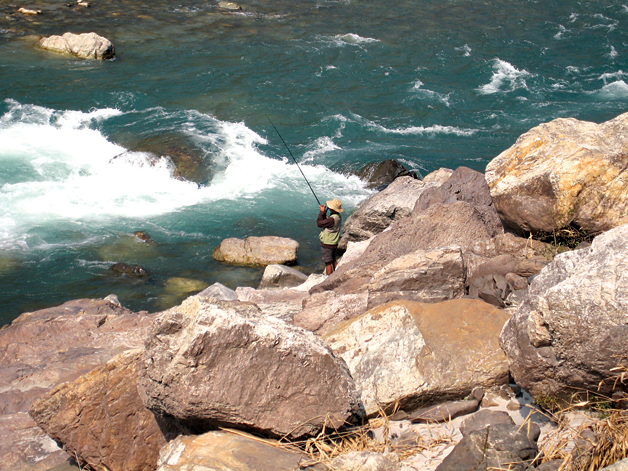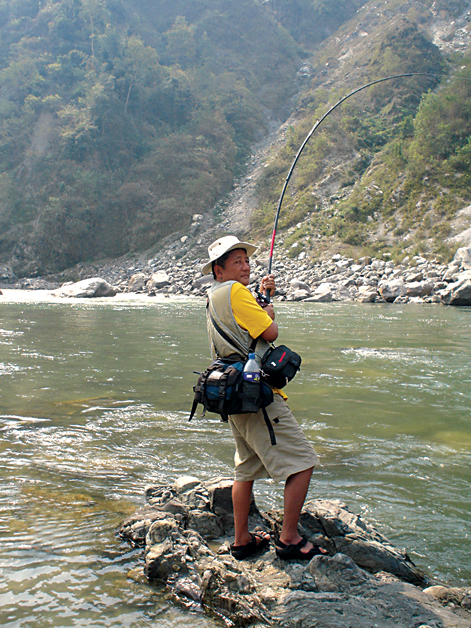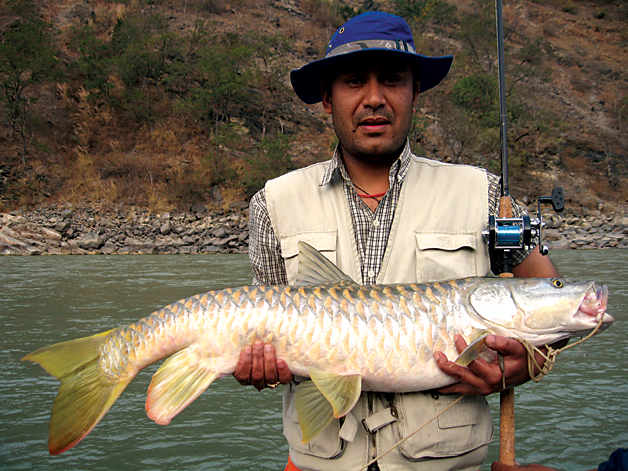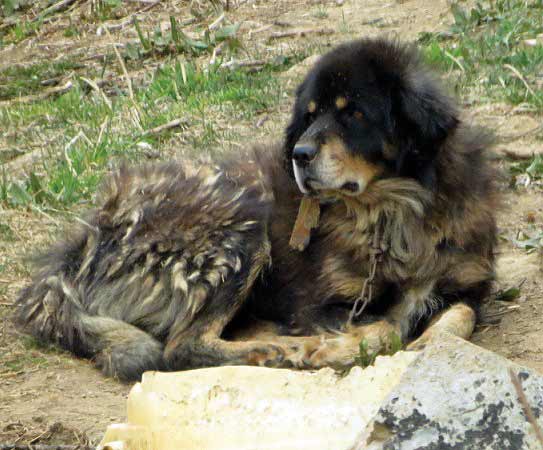Of all the mammoth challenges still facing the world’s fishermen today, mahseer along the Himalayas is one of the greatest. Anyone who goes to the Himalayas and pulls off a fish or two has really recorded a triumph, a place in the history of fishing,” writes John Bailey (a writer, photographer and world class angler, in Casting for Gold, an award-winning BBC documentary based on mahseer angling along the legendary Ganges at Vyasghat, North India). The “hook”, the “rush” and the ultimate “fight” that follows to land “the Big One”, the “tiger of the waters”—the mahseer, is the defining moment that sends every angler’s adrenalin hopping mad. An adventure par excellence. Bailey was so enthralled by this Himalayan fish that he started a travel outfit of his own, organizing fishing expeditions to India. Nepal, a country in the lap of the Himalayas, is literally a maze of rivers, snow-fed and spring-fed, eventually flowing down south to merge with the sacred waters of the Ganges. And many of these rivers are home to the legendary mahseer.

Patient wait to hook the ‘big one’
Birth of adventure tourism
Literally cut off from the rest of the world until the 1950s, Nepal saw the dawn of tourism after a handful of adventure seekers from foreign lands set foot on this little “mythological Shangri-La,” to scale the Himalayas. The Nepalese history, however, was rewritten with the conquest of Everest by the intrepid duo, Tenzing and Hillary in 1953. This event catapulted this little known country to world fame. Adventure tourism, thus, saw its birth in Nepal. With time, it diversified. After the top draw adventure attraction of mountaineering, came trekking, followed by wildlife safari and white-water rafting. Man’s hunger for more adventure, however, would not let up.
Old concepts turned passé. To woo more tourists, newer concepts like ‘eco-tours’, ‘green tours,’ ‘cultural tours,’ ‘soft-tours’ and the like heralded a revamping of the travel notion. Today, braver diversions are being sought, in the likes of rock climbing, canoeing, paragliding, hot air ballooning, mountain biking and bungee jumping.
World-wide sport
Surprisingly, angling or fishing tours in Nepal remain an uncharted domain waiting to be explored and tapped. Neighboring India, on the other hand, has made quite a leap into this field. Sport fishing in India has flourished substantially in the last decade and almost every travel operator includes angling trips in their holiday itineraries. This adventure sports lures worldwide anglers to India in pursuit of the legendary Golden mahseer, the ultimate dream-fish of every serious fresh water angler. The upper Ganges, her many tributaries in North India, and the river Cauvery in the south are famous for mahseer.
 Avid anglers from around the world are known to travel thousands of miles to India in pursuit of this charismatic game fish, spending fortunes - upwards of three thousand dollars per person for a single trip. Tours are typically booked up to a year in advance through travel agents or online. All such angling is done strictly on a ‘catch-n-release’ footing; that is, you catch a mahseer, gingerly hold it in your arms, weigh it, measure it, pose with it for a photo, then release it gently back into the waters where it belongs. Proclaimed as endangered, the Indian government has taken this step to preserve this species.
Avid anglers from around the world are known to travel thousands of miles to India in pursuit of this charismatic game fish, spending fortunes - upwards of three thousand dollars per person for a single trip. Tours are typically booked up to a year in advance through travel agents or online. All such angling is done strictly on a ‘catch-n-release’ footing; that is, you catch a mahseer, gingerly hold it in your arms, weigh it, measure it, pose with it for a photo, then release it gently back into the waters where it belongs. Proclaimed as endangered, the Indian government has taken this step to preserve this species.
The Himalayan fighter
Angling for golden mahseer fish in the torrential waters of the Himalaya, is a great experience. Known to fight like cornered leopards, they exhibit brute power and lightning speed that no other fresh water fish—allegedly not even its ferocious western cousin, the salmon--can match. A big mahseer sends shivers down every angler’s spine and even the most accomplished angler is humbled by its unbridled fury and unpredictable behavior. Notoriously difficult to catch, angling for this species is also a daunting challenge. It demands great deal of travel effort, dogged patience, stamina to brave rugged terrain, fearsome rapids, and sometimes unpredictably harsh weather conditions. And, ultimately, a strong purpose of mind is mandatory to revel and digest both success and failure.
The mahseer angler must perform like a stubborn mountaineer who keeps scaling the heights no matter what it takes. Time and again he frequents that river bank where he has known luck or failure, and hardship. The modern day tackle for fishing mahseer includes state-of-the-art reels on high density carbon or graphite rods, top-of-the-shelf lines and myriad lures. This sport demands the finest there is because the entire tackle is pushed to the limit. Smashed rods, mangled hooks, broken lines and shattered reels are not uncommon, particularly if an angler fails to handle a big one that decides to dash for the nearest rapid. Someone has equated grappling a big mahseer with doing a 10-round bout with Mike Tyson, with unpredictable results! The prize is worth grappling with the unbridled fury of this fiesty fighter
Fishing for mahseer is a great sport enjoyed for ages by Nepali fishermen with their age-old primitive methods or today’s anglers with modern day tackles. And every mahseer catch is prized very highly. My angling tours to the Sapta Koshi, Arun, Tammar, and Tama Koshi rivers in the east and to the Karnali, Trishuli and Babai in the west have revealed many big mahseer catches, from 10 to 35 kilos made by the local riverside people. Most of such catches are made on thapuwa balchhi―hooks baited with live fish cast at night and retrieved in the morning. Occasional footages of catches (from 8 to 20 kilos) made by some British, American and Russian mahseer aficionados on our rivers (Karnali, Sunkoshi, Tammar and Kali Gandaki) with modern rod-n-line can also be viewed on the internet. This sort of adventure, though brimming over with great potential, has not been yet fully realized as an up-scale tour in itself, in Nepal.
Endemic species
Mahseer (sahar in Nepali) is a migratory cold water fish that spawns during monsoon floods (June-September). Much the same as the salmon travels hundreds of miles upstream to spawn, the mahseer ascents up-river to considerable heights (from as low as 300 ft to 2,500ft from sea level), to placid spring-fed feeder streams, to deposit their eggs. After the monsoon they return to the foothills, then migrate back again to the upper reaches to breed where there are many snow and glacier-fed rivers, the mahseers’ natural habitat. Nepal, therefore, offers abundant opportunities for mahseer fishing. All of our large Himalayan river systems hold plenty of mahseer, especially upland yellow-finned Golden Mahseer (Barbus tor putitora) coveted by all anglers for its unparallel fight and size. It’s been known to reach 80 to 100 pounds. Nepal also hosts the lowland, deep bodied Red-Finned Mahseer (Tor tor), which grow up to 50 pounds, as well as the midland Copper Mahseer (Katle/neolissocheilus hexagonolepis) weighing up to 15 pounds.
Exact timing for mahseer angling in our rivers is tricky, as each river varies in its characteristics, making the timing of fish runs notoriously difficult to predict. The anglers and the local fishermen generally intercept them when on their migratory run. As a general guide, the best angling can be done in autumn and spring. The autumn (late September and October) is when the tributaries are dropping, the rivers are beginning to clear after the monsoon, and the spent fish are descending after spawning in the upstream hill torrents. Springtime (from March into early May) is when the fish are migrating upwards to their spawning grounds. Note that during the monsoon months (June, July and August), fishing is closed, as this is when they breed.
Great potential
Given meticulous planning and customized escorted destinations, mahseer angling, as an adventure travel destination in Nepal, can definitely flourish. Other tour packages like wildlife safaris, white-water rafting, nature trekking, and bird-watching can be mutually supportive, and impart further impetus to such ventures. First, a careful study and surveys of potential mahseer waters, evaluation of the present status of our water courses and their resident mahseer runs, and informed selection of river stretches least affected by human proximity and poaching are essential.

Emulating our Indian neighbors, all angling operations can be managed either from fixed station river-side camps or lodges, or by mounting short or long expeditions by river rafting combined with short hikes. Some guidelines to consider:
- Conduct angling trips on day-by-day basis from established camps or lodges located near fishing waters. In Bardiya National Park there are several resorts that can work as established bases from which to fish the Karnali and Babai rivers. The roadside town of Chisapani can also serve as a base for fishing the upper Karnali and confluences like the Karnali-Bheri and Karnali-Seti.
- Organize expeditions or customized trips ranging from seven to fifteen or twenty-one days by raft or short treks. Given proper planning, our rivers offer plenty of opportunities, both by raft or short hikes. There are many rafting companies that can accommodate such a schedule. Some options are: Dolalghat/Chhatara Ghat river rafting with innumerous tributaries feeding themselves into the Sunkoshi river in the central Nepal hills, or short hikes from Mulghat in east Nepal’s Dhankuta District to Tribeni along the river Tammar, or from Maibeni in east Nepal’s Bhojpur District to the confluence of the Pikhuwa and Arun rivers, or from west Nepal’s Bheri-Karnali confluence to Chisapani.
- If close to a national park, the fishing package can be enhanced and diversified by adding other activities: nature walks, elephant safaris, bird-watching, village tours, canoe trips, white water rafting, cultural tours, pony rides, and so on.
As loss of bio-diversity and rapid depletion of natural resources continue, the status of this endemic game fish is also far from satisfactory. Over the years, the mahseer population has gone down. Human interventions and total apathy toward its conservation by the authorities, and indiscriminate killing of fish have caused this decline. Thus, we cannot expect to develop this adventure sport unless we develop in-depth guidelines and a strategy that combines both transplantation and conservation to revive this threatened species, as well as other game fish like gounch (a catfish), which can grow to a whopping 250 kilos, and asla (snow trout). The gounch is regarded as a formidable quarry by anglers, and fly-fishing for trout is regarded as a great sport world-wide.
Over the past few decades, tourism in Nepal has gone through a dramatic diversification, with adventure tourism possibly overtaking other forms of tourism. The challenge however, is to continue to grow. Newer and bolder possibilities abound, waiting to be explored. A recent news item headlined “Nat Geo hails thrill seekers’ paradise” pointed out that National Geographic has identified Nepal and Brazil among the top draw adventure destinations in the world. This is welcome news, and given proper promotion, angling for mahseer, in our torrential snow-fed rivers tucked into the foothills of the exotic Himalayas, can guarantee visitors newer horizons of virgin wilderness, adventure, and dish out a truly ‘mind boggling itinerary’.
Hooked
For every visiting angler in pursuit of the awe-inspiring mahseer, the foray kicks off with the sprawling countryside, and from one moment to the next nature unfolds its bounty. Along the undulating myriad of wooded hills, awesome gorges appear as the rivers rage and crash through them breaking into thousands of churning white rapids. Suddenly, lush green mountain valleys appear as the crystal clear spring-fed headwaters meander past verdant subtropical jungles and pour themselves into the big rivers. Time and again, incredible sights of wildlife and sounds of nature greets the untrained ear. Many a village crosses the trail, offering rare moments to share with the local people and observe unique customs, beliefs and diverse ethnic culture. As the foothills appear, the murmur and the rumble of the river beckons, and the angler cannot wait to make his cast. Fascinated, he spots a kingfisher that suddenly makes a swooping dive and flies off with its prize catch. Next his heart skips a beat as a mugger crocodile breaks surface to laze on the sandy beach, and a little later he gawks unbelievingly at a handsome stag that approaches the other side of the river for a drink. And all this time the ultimate quest for that elusive “Big One”—“the mighty mahseer” of his dream haunts his mind. He is truly hooked—hook, line and sinker.
ravimansingh@hotmail.com











